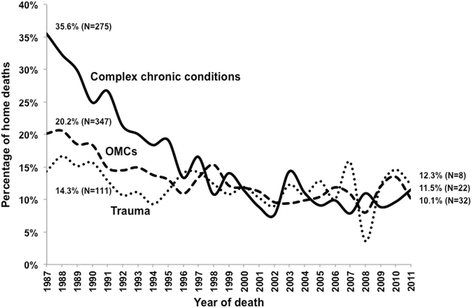Trends in cause and place of death for children in Portugal (a European country with no Paediatric palliative care) during 1987-2011: a population-based study
- PMID: 29273020
- PMCID: PMC5741889
- DOI: 10.1186/s12887-017-0970-1
Trends in cause and place of death for children in Portugal (a European country with no Paediatric palliative care) during 1987-2011: a population-based study
Abstract
Background: Children and adolescents dying from complex chronic conditions require paediatric palliative care. One aim of palliative care is to enable a home death if desired and well supported. However, there is little data to inform care, particularly from countries without paediatric palliative care, which constitute the majority worldwide.
Methods: This is an epidemiological study analysing death certificate data of decedents aged between 0 and 17 years in Portugal, a developed Western European country without recognised provision of paediatric palliative care, from 1987 to 2011. We analysed death certificate data on cause and place of death; the main outcome measure was home death. Complex chronic conditions included cancer, cardiovascular, neuromuscular, congenital/genetic, respiratory, metabolic, gastro-intestinal, renal, and haematology/immunodeficiency conditions. Multivariate analysis determined factors associated with home death in these conditions.
Results: Annual deaths decreased from 3268 to 572. Of 38,870 deaths, 10,571 were caused by complex chronic conditions, their overall proportion increasing from 23.7% to 33.4% (22.4% to 45.4% above age 1-year). For these children, median age of death increased from 0.5 to 4.32-years; 19.4% of deaths occurred at home, declining from 35.6% to 11.5%; factors associated with home death were year of death (adjusted odds ratio 0.89, 95% confidence interval 0.89-0.90), age of death (6-10 year-olds 21.46, 16.42-28.04, reference neonates), semester of death (October-March 1.18, 1.05-1.32, reference April-September), and cause of death (neuromuscular diseases 1.59, 1.37-1.84, reference cancer), with wide regional variation.
Conclusions: This first trend analysis of paediatric deaths in Portugal (an European country without paediatric palliative care) shows that palliative care needs are increasing. Children are surviving longer and, in contrast with countries where paediatric palliative care is thriving, there is a long-term trend of dying in hospital instead of at home. Age, diagnosis, season and region are associated with home death, and should be considered when planning services to support families choosing this option. Priorities should address needs of the youngest children, those with cancer, neuromuscular and cardiovascular conditions, as well as inequities related to place of residence.
Keywords: Child; Epidemiology; Health services; Mortality; Palliative care.
Conflict of interest statement
Authors’ information
AL is a paediatric oncologist with decades of experience in caring for children and families with palliative care needs. After completing her MSc degree at King’s College London she has undertaken a pivotal role in the development of paediatric palliative care in Portugal. BG, with a psychology background, is a renowned researcher in the field of palliative care, both in the UK and in Portugal, where she is taking forward the development of homecare services based on high-quality evidence.
Ethics approval and consent to participate
The study protocol was submitted to appreciation by the King’s College London Research Ethics Office and it was considered as not requiring approval by a Research Ethics Committee, since the data were pseudo-anonymised and non-sensitive, referring to deceased subjects.
Consent for publication
Not applicable.
Competing interests
All authors declare that they have no competing interests.
Publisher’s Note
Springer Nature remains neutral with regard to jurisdictional claims in published maps and institutional affiliations.
Figures


References
-
- European Association for Palliative Care Taskforce for palliative care in children. Palliative care for infants, children and young people - the facts. Fondazione Maruzza Lefebvre D'Ovidio Onlus. 2009. http://www.eapcnet.eu/LinkClick.aspx?fileticket=DeiV2yhtOZA%3D. Accessed 16 June 2016.
-
- Strengthening of palliative care as a component of comprehensive care throughout the life course. World health assembly. 2014. http://apps.who.int/gb/ebwha/pdf_files/WHA67/A67_R19-en.pdf. Accessed 16 Jun 2016. - PubMed
-
- Knapp C, Woodworth L, Wright M, Downing J, Drake R, Fowler-Kerry S, et al. Pediatric palliative care provision around the world: a systematic review. Pediatr Nurs. 2011;57(3):361–368. - PubMed
Publication types
MeSH terms
LinkOut - more resources
Full Text Sources
Other Literature Sources
Medical
Miscellaneous

